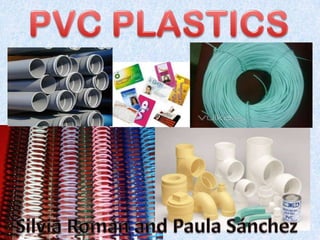PVC plastics
- 2. DESCRIPTION It´s a polymer derived from two natural raw materials: -Sodium chloride or common salt and oil or natural gas. -Its original form is a white, amorphous powder & opaque. -It is odorless, innocuous tasteless and to chemicals. -High resistance to compression crushing -It is very economical
- 3. DESCRIPTION • It is light and non-flammable so it is classified as flame retardant material. • It does not degrade or dissolve in water. • It´s recyclable. Will not rust or corrode, with long service life. • High resistance to compression crushing • Easily picklable, acarreable and transportable.
- 4. Is PVC plastic recyclable? PVC is easily recyclable and recycled once has many applications. If we study history, we see that PVC recycling is as old as manufacturing. The recycling of PVC is technologically simple and feasible from an economic point of view, existing in Europe an important very competitive recycling industry.
- 5. History • In 1835 Justus discovered vinyl chloride by reacting ethylene di-chloride with potassium. • In 1915, Fritz Klatte achieved polymerize vinyl chloride. • In 1926 production begins in Germany. • In 1953, Ziegler developed polyethylene. • In 1954 Giulio Natta polypropylene developed. • In 1959 was born in Costa Rica marketing PVC pipes.
- 6. Specific properties About PVC resistance: Excellent resistance to dilute: concentrated acids, alcohols, bases, aliphatic hydrocarbons and mineral oils. Good resistance to vegetable oils and oxidizing agents. Limited resistance to aldehydes. Poor resistance (not recommended for use) with aldehydes, esters aromatic and halogenated hydrocarbons and ketones.
- 7. Some interesting facts about PVC properties: o Maximum Temperature: 158°F 70°C o Minimum Temperature: -13°F -25°C o Autoclavable: No o Melting Point: 176°F 80°C o Tensile Strength: 6,500 psi o Hardness: R105 o UV Resistance: Good o Clear o Rigid o Specific Gravity: 1.34
- 8. Uses Construction:1. Wire and cable insulation 2.Door frames and windows 3.Ducts and pipes 4Profiles. Toys: 1. Dolls. 2.Balls. 3.Swimming pools for children. 4Duck Bath Cars: 1.Boards. 2.Power Cables. 3.Air filters and oil. 4.Seats General Uses: Shoes. 2.Credit cards. 3.Photo albums. 4.Blinds Medicine:1.Pipes.2.Surgical gloves.3.Bags sera.4. Dialysis
